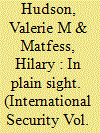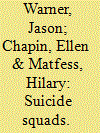|
|
|
Sort Order |
|
|
|
Items / Page
|
|
|
|
|
|
|
| Srl | Item |
| 1 |
ID:
185835


|
|
|
|
|
| Summary/Abstract |
The 1983–1985 famine in Ethiopia is perhaps one of the most internationally recognized instances of acute human suffering. Although the international community’s response to the crisis and the ways in which the famine reshaped the nature of humanitarian aid have been probed, less often discussed is that one of the most effective relief organizations delivering assistance—the Relief Society of Tigray (REST)—was the humanitarian wing of an insurgency, the Tigrayan People’s Liberation Front (TPLF). This article asserts that the process of responding to the famine amidst a protracted civil war left an indelible mark on the ways in which the TPLF approached domestic civil society and international assistance after war as a part of the governing party, the Ethiopian People’s Revolutionary Democratic Front. This article describes the legacies of the rebels’ wartime humanitarian activities. It asserts that REST’s prominence as an organization, its role as a model and catalyst for other party-affiliated organizations, the government’s suspicion of domestic civil society and efforts to strictly control international assistance, and its reliance on service delivery to bolster its domestic legitimacy are all legacies of the rebels’ wartime governance. In doing so, this article calls for greater attention to the dynamics of rebels’ wartime humanitarian activities and the post-conflict implications of this form of rebel governance.
|
|
|
|
|
|
|
|
|
|
|
|
|
|
|
|
| 2 |
ID:
153630


|
|
|
|
|
| Summary/Abstract |
Approximately seventy-five percent of the world's population lives in countries where asset exchange upon marriage is obligatory. Rising brideprice—money or gifts provided to a woman's family by the groom and his family as part of marriage arrangements—is a common if overlooked catalyst of violent conflict. In patrilineal (and some matrilineal) societies where brideprice is practiced, a man's social status is directly connected to his marital status. Brideprice acts as a flat tax that is prone to sudden and swift increases. As a result, rising brideprice can create serious marriage market distortions that prevent young men, especially those who are poor or otherwise marginalized, from marrying. This phenomenon is especially evident in polygamous societies, where wealthy men can afford more than one bride. These distortions incentivize extra-legal asset accumulation, whether through ad hoc raiding or organized violence. In such situations, rebel and terror groups may offer to pay brideprice—or even provide brides—to recruit new members. Descriptive case studies of Boko Haram in Nigeria and various armed groups in South Sudan demonstrate these linkages, while an examination of Saudi Arabia's cap on brideprice and its efforts to arrange low-cost mass weddings illustrates the ways in which governments can intervene in marriage markets to help prevent brideprice-related instability. The trajectory of brideprice is an important but neglected early indicator of societal instability and violent conflict, underscoring that the situation and security of women tangibly affect national security.
|
|
|
|
|
|
|
|
|
|
|
|
|
|
|
|
| 3 |
ID:
191455


|
|
|
|
|
| Summary/Abstract |
In an effort to produce a more holistic and nuanced understanding of the violence women face in conflict, this article describes al Shabaab and Boko Haram’s respective patterns of political violence targeting women and compares them to one another. This article also describes and compares their respective political violence targeting civilians. This analysis, using data from the the Armed Conflict Location & Event Data Project (ACLED), provides three insights. Firstly, though al Shabaab and Boko Haram share a number of theoretically important characteristics, the nature of their violence targeting women differs considerably. Secondly, this comparison suggests that violence targeting women should be considered a distinct form of violence targeting civilians. Thirdly, this review sheds light on the degree to which different instrumentalist and ideological explanations, not theories of violence targeting civilians explain al Shabaab and Boko Haram’s patterns of violence. Ultimately, this article finds that a counter-insurgency plan, counter-terrorism strategy, or academic analysis that takes the same approach to al Shabaab and Boko Haram on the basis of their shared identities as Salafi-jihadist rebel groups will fail to capture important differences in their targeting patterns.
|
|
|
|
|
|
|
|
|
|
|
|
|
|
|
|
| 4 |
ID:
164066


|
|
|
|
|
| Summary/Abstract |
What strategic logics underlie terrorist groups’ use of linked suicide attacks? Are the goals that groups seek to achieve when sending linked bombing teams somehow inherently different than when sending individual suicide bombers? To answer these questions, this article introduces three typologies of linked suicide bomber detonation profiles—simultaneous, sequential, and nonproximate—and theorizes why terrorist groups might view each type of linked suicide bombing to be preferable to deploying a single suicide bomber. Improvements resulting from using an individual attacker include: ensuring a higher likelihood of successfully hitting a given target (simultaneous detonations); causing more casualties than a single bombing (sequential-wave detonations); and engendering wider-spread shock and awe (nonproximate detonations). Drawing on an original dataset detailing the entirety of Boko Haram’s suicide bombing efforts from 2011 to 2017, we then examine the extent to which these linked bombing typologies do actually appear to successfully lead to an improvement over the deployment of single suicide bombers. While we find that sequential-wave and nonproximate suicide bombings demonstrate evidence of hypothesized improvements over the deployment of single suicide bombers, our data show that deploying simultaneous suicide attackers does not lead to higher efficacy at targeting when compared to the deployment of individual bombers. In attempting to account for this fact, we argue that Boko Haram’s simultaneous detonation teams likely fail to show an improvement over single-bomber attacks because they tend to be composed of what we call “unenthusiastic and under-trained” bombers: teams of often uncommitted women, and sometimes children, which it deploys in tandem in a bid to avoid individual defection and increase the likelihood of at least one detonation in an attack. We conclude by suggesting what the process of linked bombing reveals about both terrorist groups in general and Boko Haram specifically.
|
|
|
|
|
|
|
|
|
|
|
|
|
|
|
|
|
|
|
|
|